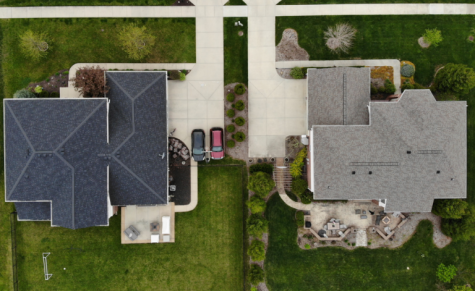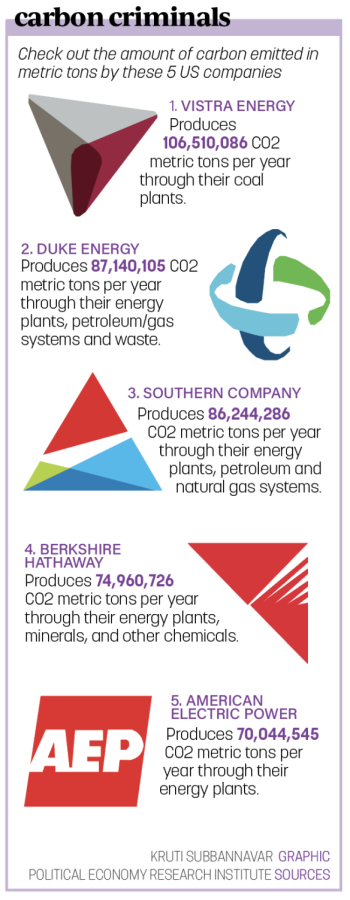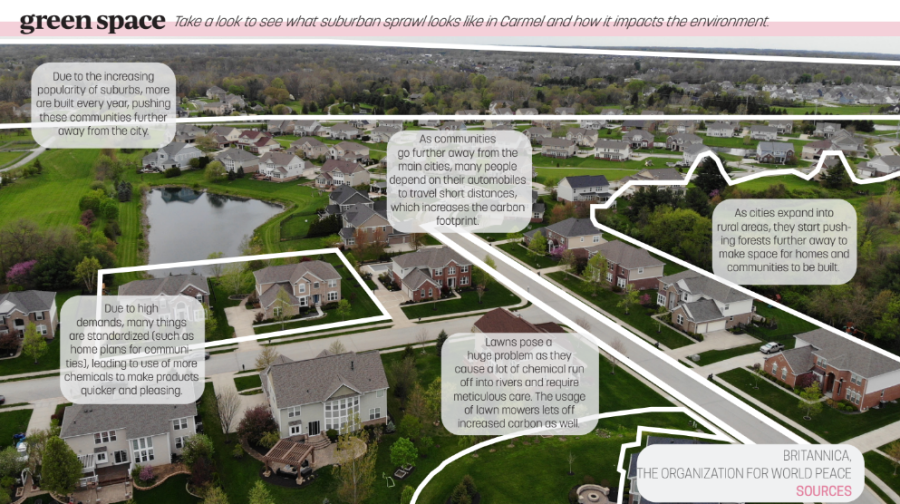A paradox of modern life is that many people move away from cities to come closer to nature. Often, those people end up moving into suburbs, where space is more abundant and properties encompass more land for grass, trees and gardens. This phenomenon of spacing is called “suburban sprawl,” and, ironically, it often has negative environmental effects.
Carmel, which has been named the top city in America to live in by several organizations in recent years, has consistently received positive ratings from both locals and visitors alike. However, as more people move to Carmel and the climate crisis continues to worsen, Carmel’s leaders are working to address the city’s growing environmental footprint.
One side effect of suburban sprawl is the widening of roads to accommodate a growing population. Marianne Cadio, architecture intern at Studio M, Carmel Mayor’s Youth Council (CMYC) member and senior, said the big roads that characterize suburban areas like Carmel can cause a plethora of issues.
“So I find that large roads tend to encourage not only faster driving which can cause more accidents, but because they’re so large, they increase the number of cars that will take those roads, causing not only air pollution, but noise pollution,” Cadio said. “Bats, for example, have trouble finding their way home because of the noise pollution caused by huge roads.”
In addition, she said they make areas less walkable, increasing dependence on cars.
Carmel Mayor Jim Brainard said the issue of suburban sprawl is nothing new in America.
“Well I think it’s important to look at (suburban sprawl) in a historical context,” Brainard said. “We’ve built cities that were walkable for thousands of years and then finally in 1946, months after World War II, for the first time over 25% of all households owned a car. So we started to then, for the last 75 years, design our cities for cars and not people.”
Brainard emphasized city design as a major component to a successful city.
“Everything goes back to city design,” he said. “There’s a shortage of workers today. How do we compete against places with mountains, oceans and better weather? Well, you do it through building beautiful cities. Because if you don’t, the best and brightest employees will go somewhere else, then our companies won’t be able to expand here, we won’t be able to attract new companies and eventually the city will start spiraling downhill.”
That design, according to Brainard, includes providing ways to reduce automobile traffic. For example, to attract more people, Brainard said that Carmel has significantly increased walkability and bike paths.
“We have built about 250 miles of bike paths now,” Brainard said. “So even in large subdivisions (within the city), people can ride their bikes downtown.”
Emily Slade, also a Studio M intern, CYMC member and senior, said she agreed with Brainard and said Carmel has started working toward increasing walkability.
“Carmel right now is promoting the idea that you can easily get from your house to work to groceries, and you never really have to use a car. You can kind of see that in Midtown with the new apartment complex right next to Kroger, and then there’s a bunch of office buildings,” she said. “It makes it easier to live without a car on a day-to-day basis. I know that I generally do use a car, but I wouldn’t have to, because I do live so close.”
According to Brainard, the city also puts certain requirements on developments to address environmental issues.
“When a developer proposes a new neighborhood, part of our process is having one of our urban foresters looking at every tree and requiring developers to plant, in most cases, hundreds of trees,” he said. “Go look at IU North Hospital and you will see literally hundreds of trees on the property simply because the city required it.”
Additionally, Brainard said the city is establishing more green spaces.
“We’re acquiring as much green space as we can, particularly in the urban areas,” he said. “We are expanding our Japanese Garden right now. We also bought four buildings and tore them down and are turning it into a green space in the denser area of downtown.”
Cadio said she acknowledged how the city has taken action to preserve the environment. However, she said there is still room for improvement.
“(Brainard) is very much into being environmentally conscious… but that doesn’t change the fact that the suburbs can be very bad for the environment,” Cadio said. “But I do think the city is doing good things for the environment.”
Environmentalism and suburban sprawl also can be affected by architecture.
Slade and Cadio said multi-family and multi-purpose buildings are a large part of Studio M’s work in Carmel.
“(Mixed-use development) is basically where you have apartments and condos in the top level (of a building) and business on the bottom, which is the main goal of Carmel right now, to build up the downtown area and create more multi-family so that they can increase the walkability of the area,” Slade said. “I’m actually really happy to be doing that.”

On the other hand, given suburban residents’ current dependence on cars, Cadio said, “the more stories you have in a building, the more parking spaces you’re going to need.”
Additionally, Cadio said businesses, more than families, are very much concerned with using solar energy. However, environmentally-friendly building materials can be more expensive, which deters businesses from using them, according to Slade.
Overall, Slade and Cadio both said they feel Carmel is moving in a more environmentally conscious direction.
“If you want to change (things), definitely attend city council meetings; they’re open to the public,” Cadio said. “It’s really easy to find out their schedule, just go to the Carmel city government website.”
Furthermore, even if individuals can’t personally end suburban sprawl, Slade said people can help counteract its effects by walking and biking as much as possible.
Brainard said that although Carmel will move to a more environmentally conscious city, the suburbs will not be able to be changed.
“I think as we continue to develop this country, we need to think about neighborhood nodes, access to neighborhood centers, better bike paths and better traffic planning,” he said. “It’s not so much that we will redo what we built the last 50, 60 or 70 years. It’s thinking about when something is going to be built on, how can we do a better job at it than we did in past years.”


































![British royalty are American celebrities [opinion]](https://hilite.org/wp-content/uploads/2024/03/Screenshot-2024-03-24-1.44.57-PM.png)


















![Review: “Suits” is a perfect blend of legal drama and humor [MUSE]](https://hilite.org/wp-content/uploads/2024/04/unnamed-1.png)
![Chelsea Meng on her instagram-run bracelet shop [Biz Buzz]](https://hilite.org/wp-content/uploads/2024/04/IMG_2446-1200x838.jpg)
![Review: Quiet on Set: The Dark Side of Kids TV is the long awaited exposé of pedophilia within the children’s entertainment industry [MUSE]](https://hilite.org/wp-content/uploads/2024/04/unnamed.jpg)
![Review: “The Iron Claw” cannot get enough praise [MUSE]](https://hilite.org/wp-content/uploads/2024/04/unnamed.png)
![Review: “The Bear” sets an unbelievably high bar for future comedy shows [MUSE]](https://hilite.org/wp-content/uploads/2024/03/unnamed.png)
![Review in Print: Maripaz Villar brings a delightfully unique style to the world of WEBTOON [MUSE]](https://hilite.org/wp-content/uploads/2023/12/maripazcover-1200x960.jpg)
![Review: “The Sword of Kaigen” is a masterpiece [MUSE]](https://hilite.org/wp-content/uploads/2023/11/Screenshot-2023-11-26-201051.png)
![Review: Gateron Oil Kings, great linear switches, okay price [MUSE]](https://hilite.org/wp-content/uploads/2023/11/Screenshot-2023-11-26-200553.png)
![Review: “A Haunting in Venice” is a significant improvement from other Agatha Christie adaptations [MUSE]](https://hilite.org/wp-content/uploads/2023/11/e7ee2938a6d422669771bce6d8088521.jpg)
![Review: A Thanksgiving story from elementary school, still just as interesting [MUSE]](https://hilite.org/wp-content/uploads/2023/11/Screenshot-2023-11-26-195514-987x1200.png)
![Review: When I Fly Towards You, cute, uplifting youth drama [MUSE]](https://hilite.org/wp-content/uploads/2023/09/When-I-Fly-Towards-You-Chinese-drama.png)
![Postcards from Muse: Hawaii Travel Diary [MUSE]](https://hilite.org/wp-content/uploads/2023/09/My-project-1-1200x1200.jpg)
![Review: Ladybug & Cat Noir: The Movie, departure from original show [MUSE]](https://hilite.org/wp-content/uploads/2023/09/Ladybug__Cat_Noir_-_The_Movie_poster.jpg)
![Review in Print: Hidden Love is the cute, uplifting drama everyone needs [MUSE]](https://hilite.org/wp-content/uploads/2023/09/hiddenlovecover-e1693597208225-1030x1200.png)
![Review in Print: Heartstopper is the heartwarming queer romance we all need [MUSE]](https://hilite.org/wp-content/uploads/2023/08/museheartstoppercover-1200x654.png)























![Review: Ladybug & Cat Noir: The Movie, departure from original show [MUSE]](https://hilite.org/wp-content/uploads/2023/09/Ladybug__Cat_Noir_-_The_Movie_poster-221x300.jpg)

![Review: Next in Fashion season two survives changes, becomes a valuable pop culture artifact [MUSE]](https://hilite.org/wp-content/uploads/2023/03/Screen-Shot-2023-03-09-at-11.05.05-AM-300x214.png)
![Review: Is The Stormlight Archive worth it? [MUSE]](https://hilite.org/wp-content/uploads/2023/10/unnamed-1-184x300.png)




